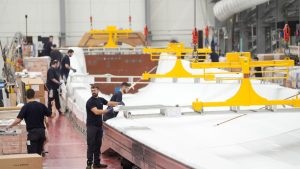The Paradox of Denim Pricing: Unraveling Why Jeans Cost What They Do
Jeans are a wardrobe staple for millions, but the vast disparity in their pricing—ranging from $50 to $500 or more—often leaves consumers baffled. The price tag on a pair of jeans doesn’t always seem to align with what you might expect, whether it’s the quality of materials, the complexity of design, or even the brand name sewn onto the back. While some are willing to splurge for the perfect fit and durability, others prefer to stick to budget-friendly options without compromising on quality. To make sense of this pricing puzzle, we spoke to fashion industry insiders, designers, and experts to uncover the factors that drive the cost of jeans.
The Role of Craftsmanship: Why Some Jeans Cost More
One of the most significant factors influencing the price of jeans is the level of craftsmanship involved in their production. Jeans with intricate designs or additional production steps naturally cost more due to the extra labor required. For instance, processes like hem grinding, hand trimming, and embroidery add layers of complexity that demand more time and skill. According to Caren Lettiere, founder and president of Democracy Clothing, these finishing processes can significantly impact the final cost. Artisanal techniques, such as hand-washing, specialized dyes, and premium embellishments like custom hardware and rivets, also drive up the price. While some details might not be immediately noticeable, they can enhance the longevity of the jeans. For example, double or chain stitching along the seams, along with an extra button sewn inside, can help the jeans withstand wear and tear over time, ultimately saving money in the long run.
The Scale of Production: How Economy of Scale Impacts Pricing
The cost of jeans is also heavily influenced by the scale of production. Larger brands often benefit from economies of scale, meaning they can manufacture jeans at a lower cost per unit. Freelance denim designer Jacqueline Diane explains that factories typically charge brands a “per piece” price, which decreases as the order size increases. This allows well-known designer brands to sometimes price their jeans lower than smaller brands producing similar quality jeans. However, if you’re looking for limited-run or exclusive styles that aren’t widely available, be prepared to pay a premium. Small batches and unique designs often come at a higher cost due to the lack of economies of scale and the exclusivity factor.
The Importance of Materials: How Fabric Quality Affects Price
The type of denim used is another key determinant of the final price. While all denim contains cotton, the quality of the fabric varies significantly. Shelley Rogers, a fashion coordinator at Earthday.org, notes that organic cotton, grown without pesticides and using less water, is more expensive than conventionally grown cotton. Countries like Japan and Italy are renowned for producing premium fabrics, with Japanese denim standing out for its high-quality cotton and advanced dyeing techniques that achieve a deep indigo color. These materials naturally come at a higher cost. On the other hand, jeans made from 100% cotton are generally more durable and expensive than those blended with synthetic materials like polyester, which are cheaper and often used to reduce costs. However, synthetic blends can offer benefits like stretch or a more structured look, which some consumers find appealing.
The Cost of Ethics: How Sustainability and Fair Labor Practices Impact Pricing
Another critical factor driving the cost of jeans is the commitment to ethical practices. If a pair of jeans costs $20, it often raises red flags about the fairness of the supply chain. As Jacqueline Diane puts it, “Something has gone terribly wrong” if jeans are priced that low, as it likely means someone in the production process wasn’t paid a fair wage. Brands that prioritize ethical labor practices and sustainable manufacturing methods typically charge more for their products. This includes ensuring fair wages for workers and adopting environmentally friendly production processes. For example, companies that dispose of dyes in an eco-friendly manner or use sustainable materials incur higher costs, which are then passed on to consumers. While higher prices don’t always guarantee ethical practices, tools like Good On You, which rates brands based on sustainability, and certifications like B Corp can help consumers make informed choices.
The Power of Branding: How Perception Influences Price
Brand names play a significant role in the pricing of jeans, often inflating the cost beyond the actual quality or materials used. Larissa Lowthorp, founder of Lunescape, explains that branding is largely about perception, and consumers often pay a premium for a brand’s image rather than its product. Many luxury brands use similar manufacturing techniques and materials as mass-market brands but charge significantly more due to their investment in marketing, fashion shows, and high-end retail spaces. This doesn’t necessarily mean that expensive jeans are of lower quality, but it does mean that the price tag often reflects more than just the jeans themselves. To determine if a brand’s price aligns with its quality, consumers should look for specific design elements like thick, heavy denim, tight stitching, and unique finishes.
How to Spot Quality: A Guide to Assessing the Value of Your Jeans
With so many factors influencing the price of jeans, it can be challenging to determine whether you’re paying for quality or just a brand name. Shelley Rogers recommends examining the jeans for signs of craftsmanship, such as crisp, clean folds and even, durable stitching. She also suggests checking for details like specialized finishes or premium hardware, which can justify a higher price. Additionally, ensuring that no dye transfers onto your hands when you handle the jeans is a good indicator of quality. While price isn’t always a perfect measure of value, combining these observations with a brand’s commitment to sustainability and ethical practices can help you make a more informed decision. Ultimately, the key to finding the right pair of jeans is identifying what matters most to you—whether it’s fit, durability, style, or ethical production—and being willing to invest in those qualities.















